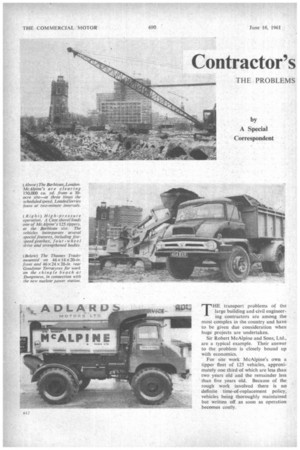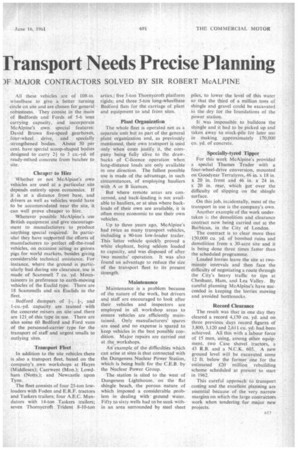Contractor's Transport Needs Precise Planning
Page 46

Page 47

If you've noticed an error in this article please click here to report it so we can fix it.
THE PROBLEMS )F MAJOR CONTRACTORS SOLVED BY SIR ROBERT McALPINE
by A Special Correspondent
THE transport problems of the large building and civil engineering contractors are among the most complex in the country and have to be given due consideration when huge projects are undertaken.
Sir Robert McAlpine and Sons, Ltd., are a typical example. Their answer to the problem is closely bound up with economics.
For site work McAlpine's own a tipper fleet of 125 vehicles, approximately one third of which are less than two years old and the remainder less than five years old. Because of the rough work involved there is no definite time-of-replacement policy, vehicles being thoroughly maintained but written off as soon as operation becomes costly. All these vehicles are of 108-in. wheelbase to give a• better turning circle on site and are chosen for general robustness. They consist in the main of Bedfords and Fords of 5-6 tons carrying capacity, and incorporate McAlpine's own special features: David Brown five-speed gearboxes, four-wheel drive, and specially strengthened bodies. About 50 per cent. have special scoop-shaped bodies designed to carry 2-I to 3 cu.-yd. of ready-mixed concrete from batcher to Site.
Cheaper to Hire
Whether or not McAlpine's own vehicles are used at a particular site depends entirely upon economics. If it is at a distance from base, and drivers as well as vehicles would have to be accommodated near the site, it can well prove cheaper to hire.
Wherever possible McAlpine's use British equipment and give encouragement to manufacturers to produce anything special required. In particular they have supported the efforts of manufacturers to perfect off-the-road vehicles, on occasion acting as guinea pigs for world markets, besides giving considerable technical assistance. For instance, where the ground is particularly bad during site clearance, use is made of Scammell 7 cu. yd. Mountaineers in preference to earth-moving vehicles of the Euclid type. There are , 18 Scammells and six Euclids in the fleet.
• Bedford dumpers of 1-, and 1-cu.-yd. capacity are teamed with the concrete mixers on site and there are 121 of this type in use. There are also soine 60 Bedford and Ford vans of the personnel-carrier type for the transport of staff and urgent smalls to outlying sites.
Transport Fleet
In addition to the site vehicles there is also a transport fleet, based on the company's own workshops at Hayes (Middlesex); Caerwent (Mon.); Lowdham (Notts.); and Newcastle upon Tyne.
The fleet consists of four 25-ton lowloaders with Foden and E.R.F. tractors and Taskers trailers; four A.E.C. Mandators with I4-ton Taskers trailers; seven Thornycroft Trident 8-10-ton artics.; five 5-ton Thornycroft platform rigids; and three 5-ton long-wheelbase Bedford flats for the carriage of plant and equipment to and from sites.
Plant Organization The whole fleet is operated not as a separate unit but as part of the general plant organization and, as previously mentioned,, their own transport is used only when costs justify it, the company being fully alive to the drawbacks of C-licence operation when long-distance loads are only available in one direction. The fullest possible use is made of the advantage, in such circumstances, of employing hauliers with A or B licences.
But where remote areas are concerned, and back-Loading is not available to hauliers, or at sites where backloads of their own are available, it is often more economic to use their own vehicles.
Up to three years ago, McAlpine's had twice as many transport vehicles, including a 90-ton low-loader trailer. This latter vehicle quickly proved a white elephant, being seldom loaded to capacity, and was disposed of after two months' operation. It was also found an advantage to reduce the size of the transport fleet to its present Strength.
Maintenance
Maintenance is a problem because of the nature of the work, but drivers and staff are encouraged to look after their vehicles and inspectors are employed in all workshop areas to ensure vehicles are efficiently maintained. Only manufacturers' spares are used and no expense is spared to keep vehicles in the best possible condition. Major repairs are carried out at the workshops.
An example of the difficulties which can arise at sites is that connected with the Dungeness Nuclear Power Station, which is being built for the C.E.B. by the Nuclear Power Group.
The station is sited to the west of Dungeness Lighthouse. on the• flat shingle beach, the porous nature of which imposed a considerable problem in dealing with ground water. Fifty to sixty wells had to be sunk within an area surrounded by steel sheet piles, to lower the level of this water so that the third of a million tons of shingle and gravel could be excavated in the dry for the foundations of the power station.
It was impossible to bulldoze the shingle and it had to be picked up and taken away to stock-pile for later use in making approximately 170,000 cu. yd. of concrete.
Specially-tyred Tipper For this work McAlpine's provided a special Thames Trader with a four-wheel-drive conversion, mounted on 'Goodyear Terratyres, 46 in. x 18 in. x 20 in. front and 46 in. x 24 in. x 20 in. rear, which got over the difficulty of slipping on the shingle surface.
On this job, incidentally, most of the transport in use is the company's own.
Another example of the work undertaken i the demolition and clearance contract now being carried out at the Barbican, in the City of London.
The contract is to clear more than 150,000 cu. yd. of bombed ruins and demolition from a 30-acre site and it is being done three times faster than the scheduled programme.
Loaded lorries leave the site at twominute intervals and then face the difficulty of negotiating a route through the City's heavy traffic to tips at Cheshunt, Ham, and Lea Valley. By careful planning McAlpine's have succeeded in keeping the lorries moving and avoided bottlenecks.
Record Clearance The result was that in one day they cleared a record 4,150 cu. yd. and on three previous days record figures of 3,800, 3,120 and 2,611 Cu. yd. had been achieved. All this with a labour force of 15 men, using, among other equipment, two Case shovel tractors, a 43 R.B. and a N.C.K. 605. A new ground level will be excavated some 12 ft. below the former one for the estimated £20 million rebuilding scheme scheduled at present_ to start in 1962.
This careful approach to transport costing and the excellent planning are essential because of the very narrow margins on which the large contrabtors work when tendering for major new projects.




















































































































